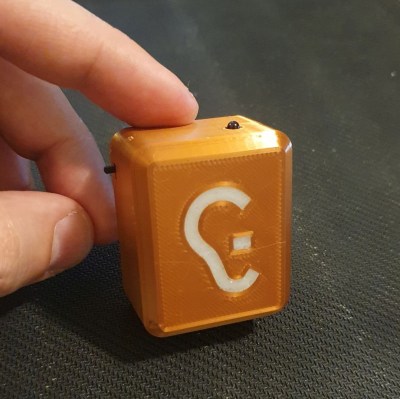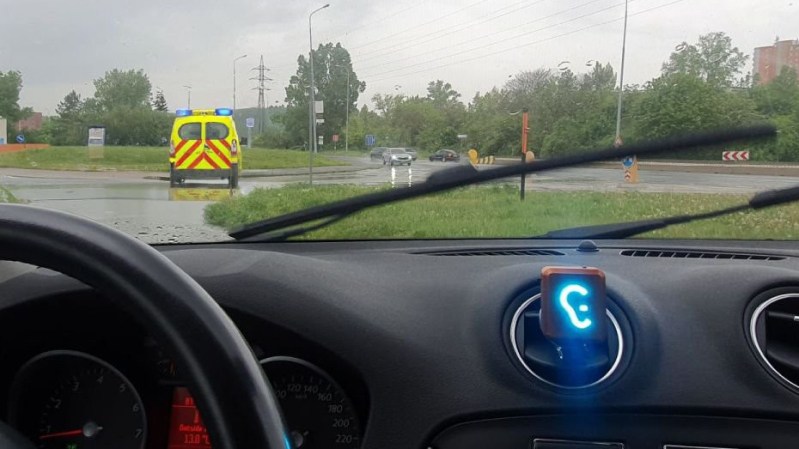[Jan Říha]’s PionEar device is a wonderful entry to the Assistive Tech portion of the 2023 Hackaday Prize. It’s a small unit intended to perch within view of the driver in a vehicle, and it has one job: flash a light whenever a siren is detected. It is intended to provide drivers with a better awareness of emergency vehicles, because they are so often heard well before they are seen, and their presence disrupts the usual flow of the road. [Jan] learned that there was a positive response in the Deaf and hard of hearing communities to a device like this; roads get safer when one has early warning.
 Deaf and hard of hearing folks are perfectly capable of driving. After all, not being able to hear is not a barrier to obeying the rules of the road. Even so, for some drivers it can improve awareness of their surroundings, which translates to greater safety. For the hearing impaired, higher frequencies tend to experience the most attenuation, and this can include high-pitched sirens.
Deaf and hard of hearing folks are perfectly capable of driving. After all, not being able to hear is not a barrier to obeying the rules of the road. Even so, for some drivers it can improve awareness of their surroundings, which translates to greater safety. For the hearing impaired, higher frequencies tend to experience the most attenuation, and this can include high-pitched sirens.
The PionEar leverages embedded machine learning to identify sirens, which is a fantastic application of the technology. Machine learning, after all, is a way to solve the kinds of problems that humans are not good at figuring out how to write a program to solve. Singling out the presence of a siren in live environmental audio definitely qualifies.
We also like the clever way that [Jan] embedded an LED light guide into the 3D-printed enclosure: by making a channel and pouring in a small amount of white resin intended for 3D printers. Cure the resin with a UV light, and one is left with an awfully good light guide that doubles as a diffuser. You can see it all in action in a short video, just under the page break.


















We could have short range transmitters on ambulances and fire engines, enabling a sort of RDS like feature, broadcast on a loop, announcing on the car’s radio that an emergency vehicle is approaching.
Not a bad idea in general, but I don’t know many deaf people who listen to radios.
RDS is text on the display, and a completely deaf person might as well leave the radio tuned to whatever they want. Doesn’t light up or flash, though. And side note you can easily be deaf enough to need some help but not completely deaf.
“I don’t know many deaf people who listen to radios.”
How many deaf people do you know?
How many deaf people have you asked?
Without that information, your statement is content-free!
In my experience 100% of severely deaf people listen to radio and music in the car.
By “severely” I mean 110dB down in one ear and 60-80dB down in the other. If the “good” ear gets any worse, they will be eligible for a (free) cochlear implant in their “bad” ear.
Just today I was on a busy 6 lane street (3 in each direction) , and by chance detected the emergency lights in front of me, but could not hear any sirens. I have no issues with my hearing, sirens just don’t get through the noise. I didn’t hear the siren until it was approximately 75 yards away.
Before I even clicked on the “Continue reading→” here on Hackaday, I was thinking of the transmitter idea. A low power transmitter in emergency vehicles with an encrypted message (to reduce the bad hacking) could be used to notify nearby drivers to pull over. It would only transmit when emergency lights are on. The message would not require display, but to just set off an alarm in the car, be it visual, or aural. For those wanting more info (i.e. those interested in listening to emergency services radio like I am), a display, log, or text-to-speech could indicate fire department, paramedic, police, or sheriff ID’s, and maybe how many vehicles are approaching. The minimalist receiver could be just like the one in this project, and a more elaborate receiver could have a display that remained until reset, or could be scrolled with time stamps. Logging could be to an SD card.
Logging to an SD card? Have we learned nothing from Raspberry Pi? lol
But this is much simpler to implement, anywhere, without needing large amounts spent. The system you describe could be implemented now but isn’t because most people can hear sirens.
I’ve had FEW radios in my cars with the Emergency Warning System enabled since early 2000s and thought that a short range transmitter on Emergency service vehicles would be a useful addition. Without consulting the manual I think the audio was muted, regardless of source and an RED text message displayed – the examples given being ‘avalanche’ and ‘nuclear accident’. Not sure if the text is simply a message number in the radio signal and pulled from the stereo memory or configured by the transmitter, but either way an appropriate message could be displayed and muting the audio gives a better chance of hearing a siren itself.
I have a feeling there’s very simple detectors out there that just detect the distinctive strobing pattern of emergency vehicle lights. Could be wrong though.
Adding yet more gear to emergency vehicles is a burden they don’t need.
I’d consider buying one. Commuting on the motorway, sirens barely register to me over the traffic noice, before they are almost on top of me.
Same goes for motorcyclists, btw.
This should be a feature built into cars. Emergency vehicles are so loud, if you’re on the sidewalk and they pass by you, or have your window down, it’s too loud, it’s gotta be above safe limits. Yet as a driver it seems more difficult to hear them while driving. Maybe just mute the stereo of the driver…
I was thinking about a motorcycle / moped audio detector also. Many times I hear them only when they are near to my car and I cannot move to let them pass (they are going between the stopped cars).
Nice! And presumably as it uses ML it could be trained on the various different sirens in use in different places.
Might be good to have some differentiation as to which siren it’s hearing – Here in the UK there’s 3-4 I think, used by different services and different levels of GTFOthe way.
Personally I’d say the best improvement would be some directionality. Obviously it can prompt someone to look around a bit, but if the device could indicate whether the siren is in front, behind, or to the side it would be even more helpful.
Sure wish I had this around 30 years ago, when I went through intersection on green light and t-boned ambulance. We never saw each other because a semi truck was in the left turn lane, and I am deaf and never heard it coming. No serious injury, police were nervous around me because citing me meant violating American with Disability law. They eventually ruled ambulance at fault for not stopping at the intersection before proceeding through. Was a bitch to get insurance settled.
Citing you would not have been a violation of the ADA…The ambulance was at fault regardless of whether you were deaf or not.
If the only way to avoid getting the citation in that situation is to not be deaf, then the citation is certainly discriminatory.
Remember when sirens were real sirens. They had lower frequencies and were easier to hear. If they made the electronic ones duplicate that, they’d be safer, especially for people with hearing difficulties.
Many (most?) emergency vehicles *already* broadcast a radio signal (or in older systems) an optical signal, intended to signal to traffic management devices (e.g. traffic lights). It should be almost trivial to add a receiver for that signal to light an indicator in a car.
*almost* trivial, if there were any standardization in the signaling, that is…
That blue blinking light is illegal i many countries, even inside the car.
Personally I think blue LED’s should be illegal everywhere, especially blinking ones.
Emergency vehicle lights are crucial for ensuring safety during urgent situations. These lights provide high visibility, allowing emergency vehicles to navigate through traffic and alert others on the road. They play a vital role in assisting emergency responders and safeguarding the well-being of all individuals involved.
We all know this- did it seem like anyone was unaware of the reason for the lights? It’s like if you were to comment on an article about sunscreen by explaining to us how the sun works and why we enjoy it.
Very Nice Post. I was checking constantly this blog and I am impressed! Very useful info specifically the last part ?? I care for such information much. Thank you and good luck.
Is the PionEar device for sale at this time? I am deaf and would really like to try it.